|
 
 |
|
ORIGINAL ARTICLE |
|
|
|
| Year : 2014 | Volume
: 20
| Issue : 2 | Page : 148-152 |
| |
Genetic diversity of 15 autosomal short tandem repeats loci using the AmpFLSTR ® Identifiler™ kit in a Bhil Tribe Population from Gujarat state, India
Ramesh R Chaudhari, MS Dahiya
Institute of Forensic Sciences, Gujarat Forensic Sciences University, Gandhinagar, Gujarat, India
| Date of Web Publication | 14-Oct-2014 |
Correspondence Address:
Ramesh R Chaudhari
Gujarat Forensic Sciences University, Institute of Forensic Science, Sector 18/A, Gandhinagar, Gujarat
India
 Source of Support: None, Conflict of Interest: None  | 2 |
DOI: 10.4103/0971-6866.142879

 Abstract Abstract | | |
Materials and Methods: The genetic diversity and forensic parameters based on 15 autosomal short tandem repeats (STR) loci; D8S1179,D21S11, D7S820, CSF1PO, D3S1358, TH01, D13S317,D16S539, D2S1338, D19S433, vWA, TPOX, D18S51,D5S818, and FGA in AmpFLSTR® Identifiler™ kit from Applied Biosystems, Foster City, CA, USA were evaluated in saliva samples of 297 unrelated individuals from the Bhil Tribe population of Gujarat state, India to study genetic diversities and relatedness of this population with other national and international populations.
Resuits: Statistical analysis of the data revealed all loci were within Hardy-Weinberg Equilibrium expectations with the exception of the locus vWA (0.019) and locus D18S51 (0.016). The neighbour joining phylogeny tree and Principal Co-ordinate Analysis plot constructed based on Fst distances from autosomal STRs allele frequencies of the present study and other national as well as international populations show clustering of all the South Asian populations in one branch of the tree, while Middle Eastern and African populations cluster in a separate branch.
Conclusion: Our findings reveal strong genetic affinities seen between the Indo-European (IE) speaking Bhil Tribe of Gujarat and Dravidian groups of South India.
Keywords: Allelic frequencies, Bhil Tribe, genetic distance, genetic diversity, short tandem repeats
How to cite this article:
Chaudhari RR, Dahiya M S. Genetic diversity of 15 autosomal short tandem repeats loci using the AmpFLSTR ® Identifiler™ kit in a Bhil Tribe Population from Gujarat state, India. Indian J Hum Genet 2014;20:148-52 |
How to cite this URL:
Chaudhari RR, Dahiya M S. Genetic diversity of 15 autosomal short tandem repeats loci using the AmpFLSTR ® Identifiler™ kit in a Bhil Tribe Population from Gujarat state, India. Indian J Hum Genet [serial online] 2014 [cited 2016 Aug 23];20:148-52. Available from: http://www.ijhg.com/text.asp?2014/20/2/148/142879 |
 Introduction Introduction | |  |
The Bhil Tribe is one of the largest tribal communities in India and spread over continuous covering four large Indian states, namely Gujarat, Madhya Pradesh, Rajasthan, and Maharashtra. Mostly, The Bhil Tribe resides in the mountains of central western part of India [Map 1]. In Gujarat, the Bhil Tribe represents 46% of total Tribe's population. [1] The aims of study on the Bhil Tribe in Gujarat have still remained isolated and less focused. Therefore, genetic study will provide a valuable source of information to understand their genetic variability and affiliation. [2]
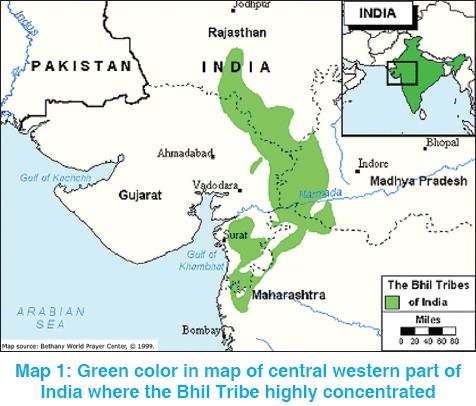
 Materials and Methods Materials and Methods | |  |
Sampling
Saliva samples were collected on the indicating FTA ® classic card (Cat # WB120206, Whatman ® , UK) by using sterile foam tipped applicators (Cat # WB 100032, Whatman ® , UK) from 297 unrelated individuals form the Bhil Tribe population of the Gujarat state, India. Samples were collected in accordance with the ethical guidelines stipulated by the institutions involved in this study.
Quality control
The research study was conducted in accordance with quality control measures as well as successfully participated in the fifth Asian American-Indonesian Cultural and Educational Foundation DNA proficiency test. A positive and negative control as specified in the Identifiler ® kit user's manual.
DNA extraction
Genomic DNA was extracted from the saliva samples using saliva FTA ® card application note [3] and QIAamp ® DNA mini kit as per manufacturer's recommendations (Qiagen, Germany).
Polymerase chain reaction amplification
Multiplex polymerase chain reaction (PCR) reaction was carried out for each DNA sample, and amplified 15 autosomal short tandem repeats (STR) loci (D8S1179, D21S11, D7S820, CSF1PO, D3S1358, TH01, D13S317, D16S539, D2S1338, D19S433, vWA, TPOX, D18S51, D5S818, and FGA) using AmpFlSTR ® Identyfiler™ PCR Amplification kit following the manufacturer's protocol and GeneAmp ® PCR System 9700 (Applied Biosystems [ABI], Foster City, CA, USA).
Electrophoresis and typing
Genotyping was performed by capillary electrophoresis; 1.5 μL of the amplified PCR product was combined with 12 μL of formamide and 0.5 μL of GeneScan 500 LIZ™ internal size standard. Detection of PCR products and genotyping were carried out on the ABI 3130 Genetic analyzer (ABI, Foster City, CA, USA) using the data collection software ® v3.0 and GeneMapper ® ID v3.2 analysis software (ABI, Foster City, CA, USA).
Statistical analysis
An estimation of allele frequencies distribution and other forensic parameters, including power of discrimination (PD), power of exclusion (PE), and matching probability (MP), polymorphism information content (PIC), and typical paternity index (TPI), were calculated using PowerStats software version 1.2. [4] (Available on http://www.promega.com/geneticidtools/powerstats) Population's genetic structure deviation from Hardy-Weinberg equilibrium (HWE), observed heterozygosity (HO) and expected heterozygosity (HE) were calculated using Arlequin v3.1. [5] Allelic frequencies from samples of the present study and other Indian's as well as International populations shown in [Table 1] were employed to generate the neighbor-joining (NJ) phylogeny tree based on Fst distances using POPTREE2 software: Naoko Takezaki, Masatoshi Nei, and Koichiro Tamura (Available on http://www.med.kagawa-u.ac.jp/~genomelb/takezaki/poptree2/index.html). [6] These Fst distance were utilized to generate a NJ phylogeny tree using the same software. The robustness of the phylogenetic relationship calculated by the NJ tree was assessed using 1000 replications bootstrap analysis. Graphical representation of genetic distance (Fst) of the population in this study along with seven national and 10 international populations were performed based on Principal Coordinate Analysis (PCA) plot using GenAlEx software v6.3. [7]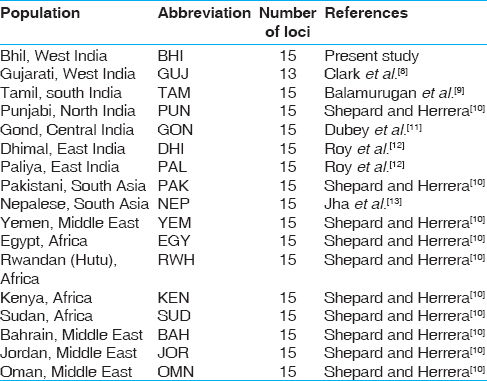 | Table 1: The national and international population data used for analysis using NJ tree and PCA plot from genetic distances
Click here to view |
 Results and Discussion Results and Discussion | |  |
The observed allele frequencies and statistical parameters based on the 15 autosomal STR markers in Bhil Tribe population are summarized in [Table 2]. A total 155 alleles at these 15 STR loci were found with corresponding allelic frequencies ranging 0.002-0.441 in the Bhil Tribe population. These STR loci were found to be highly polymorphic, and statistical analysis of these data revealed all loci met HWE expectations with the exception of vWA (0.019) and D18S51 (0.016). The combined PD and for all loci were >0.99982, while the combined MP is 2.53 × 10 17 and the average heterozygosity is 0.7720.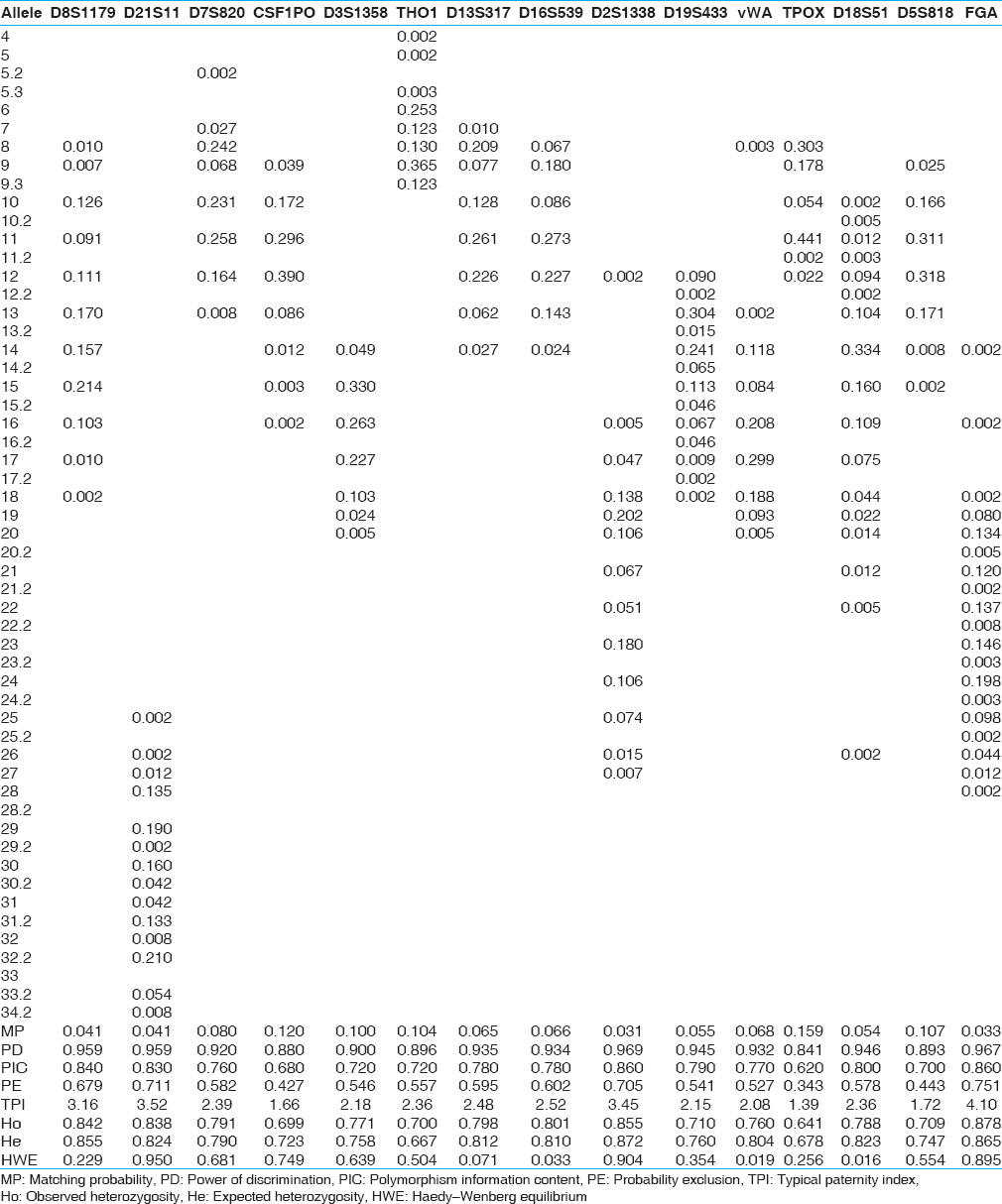 | Table 2: Allele frequencies and associated statistical parameters of AmpFLSTR® Identifiler™ Kit PCR amplification kit loci in Bhil Tribe population (n=297 samples)
Click here to view |
Fst distance was used to compare the seven national and ten global populations in relation to the allele frequencies of 15 autosomal STR loci and generate the NJ phylogeny tree shown in [Figure 1]. Examination of the NJ phylogeny tree shows the cluster of all the South Asian population as one group and other Middle Eastern with African population as other group. Nearest affinity can be seen among the Middle Eastern populations, while the three African populations branched away from the Middle Eastern group. South Asian populations cluster shows nearest affinities among the Indian population with Pakistani population (except Dhimal and Paliya). Cluster branch of Indian population of Dhimal and Paliya show nearest affinity seen with Nepali population. A PCA plots were constructed [Figure 2], the grouping of the population in the PCA plot is consistent with the clustering pattern of the NJ phylogeny tree. Moreover, The Bhil Tribe is genetically and linguistic affiliated to Indo-European (IE) group of India. [14] This is in contrast to the findings in the present study, found strong genetic similarities between the Bhil Tribe of Gujarat and Dravidian affiliated group of Gond Tribe and Tamil population, [15] whereas closely genetic affinity seen among Gujarati and Punjabi populations.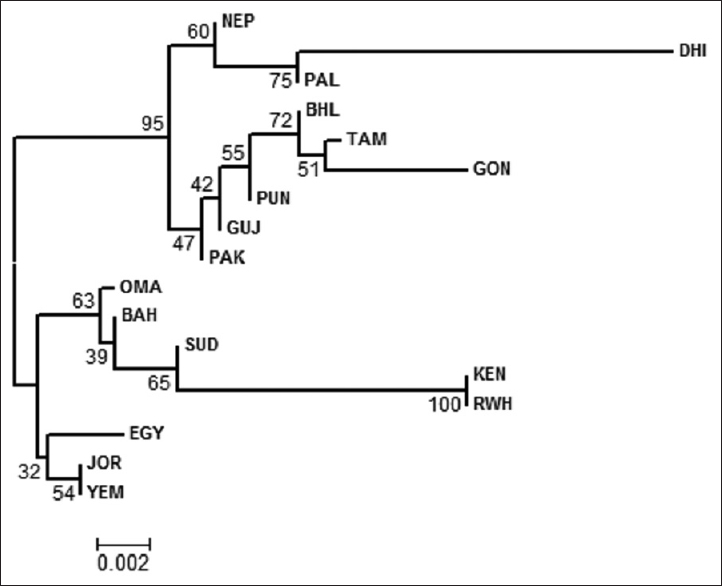 | Figure 1: Neighbor- Joining tree based on Fst distances from allele frequencies of the autosomal short tandem repeat loci. The numbers at the nodes represent bootstrap values estimated from 1000 replications. The population codes and descriptions are given in Table 1
Click here to view |
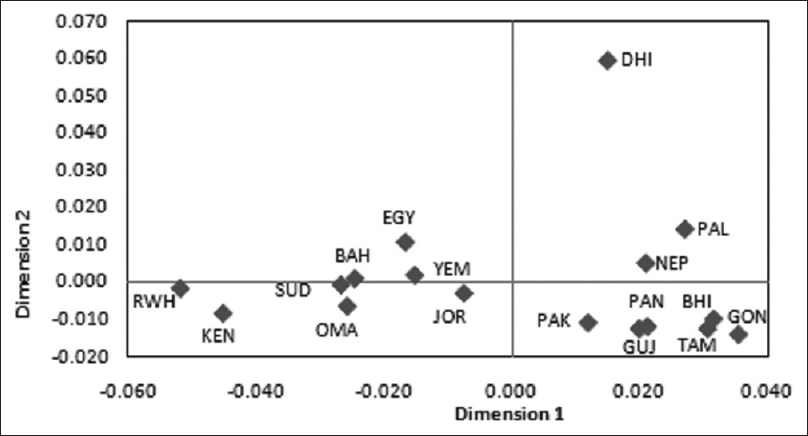 | Figure 2: Principal Coordinate Analysis of Fst distances derived from the population from the present study and National and International populations. The population codes and descriptions are given in Table 1
Click here to view |
 Conclusion Conclusion | |  |
Clustering pattern of NJ phylogeny tree, PCA plot, genetic study and hypothetical evidence supporting to the IE specking Bhil Tribe of Gujarat is genetically affiliated with Dravidian group of South India. [15],[16],[17]
 Acknowledgments Acknowledgments | |  |
The authors gratefully acknowledge Dr. J.M. Vyas, Director General, Directorate of Forensic Science, Gandhinagar, state of Gujarat, INDIA for providing laboratory facility and thank to the anonymous donors for contributing the Saliva samples for the research study.
 References References | |  |
| 1. | |
| 2. | Chaubey G, Metspalu M, Kivisild T, Villems R. Peopling of South Asia: Investigating the caste-tribe continuum in India. Bioessays 2007;29:91-100.  |
| 3. | Application note: Extraction of DNA from whatman FTA cards. GE Healthcare; 2010,28-9822-22.  |
| 4. | Tereba A. Tools for analysis of population statistics. Profiles DNA 1999;2:14-6.  |
| 5. | Excoffier L, Laval G, Schneider S. Arlequin (version 3.0): An integrated software package for population genetics data analysis. Evol Bioinform Online 2007;1:47-50.  |
| 6. | Takezaki N, Nei M, Tamura K. POPTREE2: Software for constructing population trees from allele frequency data and computing other population statistics with Windows interface. Mol Biol Evol 2010;27:747-52.  [ PUBMED] |
| 7. | Peakall R, Smouse PE. Genalex 6.5: Genetic analysis in excel. Population genetic software for teaching and research: An update. Bioinformatics 2012;28:2537-9.  |
| 8. | Clark D, Hadi S, Iyengar A, Smith J, Garg V, Goodwin W. STR data for the AmpFlSTR SGM Plus loci from two South Asian populations. Leg Med (Tokyo) 2009;11:97-100.  |
| 9. | Balamurugan K, Kanthimathi S, Vijaya M, Suhasini G, Duncan G, Tracey M, et al. Genetic variation of 15 autosomal microsatellite loci in a Tamil population from Tamil Nadu, Southern India. Leg Med (Tokyo) 2010;12:320-3.  |
| 10. | Shepard EM, Herrera RJ. Genetic encapsulation among Near Eastern populations. J Hum Genet 2006;51:467-76.  |
| 11. | Dubey B, Meganathan PR, Eaaswarkhanth M, Vasulu TS, Haque I. Forensic STR profile of two endogamous populations of Madhya Pradesh, India. Leg Med (Tokyo) 2009;11:41-4.  |
| 12. | Roy S, Eaaswarkhanth M, Dubey B, Haque I. Autosomal STR variations in three endogamous populations of West Bengal, India. Leg Med (Tokyo) 2008;10:326-32.  |
| 13. | Jha DK, Javier L, Gonzalez LJ, Rijal J, Tuladhar BS, Chhetri NT. Allele frequencies of 15 ampFLSTR identifiler loci in the Nepalese population. Sci World 2012;20:20-3.  |
| 14. | Sharma G, Tamang R, Chaudhary R, Singh VK, Shah AM, Anugula S, et al. Genetic affinities of the central Indian tribal populations. PLoS One 2012;7:e32546.  |
| 15. | Kshatriya GK, Aggarwal A, Khurana P, Singh HS, Italia YM, Saraswathy KN, et al. Genomic and linguistic affinities: A study of allelic and haplotype diversity at DRD2 locus among the tribes of Gujarat, western India. Genet Test Mol Biomarkers 2010;14:215-23.  |
| 16. | Reich D, Thangaraj K, Patterson N, Price AL, Singh L. Reconstructing Indian population history. Nature 2009;461:489-94.  |
| 17. | Majumdar DN. Blood groups of the Bhils of Gujarat. Curr Sci 1942;353:354-9.  |
[Figure 1], [Figure 2]
[Table 1], [Table 2]
|






